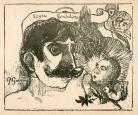Truth and Lies: Aestheticism and Symbolism in the Late 19th Century
Created by Ezra Wallach on Wed, 12/08/2021 - 14:32
Aestheticism and Symbolism in the Late 19th Century
Timeline
Chronological table
| Date | Event | Created by | Associated Places | |
|---|---|---|---|---|
| 18 Sep 1886 |
"Le Symbolisme" or "The Manifesto of SymbolismIn 1886, following the development of a new type of literature three decades in the making by Stephane Mallarme and Charles Baudelaire among other french writers, Jean Moreas (1856-1910) published the essay titled Le Symbolisme, or, The Manifesto of Symbolism, in the French daily newspaper, Le Figaro, to promote the term “Symbolism”. A well-known symbolist poet himself, Moreas felt compelled to defend against “an evolution which hasty judges have termed, unbelievably and paradoxically, decadent,” claiming that Symbolism is the “the only term capable of truly designating the present thrust of the creative spirit in art”. Aside from the Decadent Movement, Moreas details the ways in which Symbolism differs from Romanticism yet traces its roots to Romantic writers such as Alfred de Vigny. Moreas was responsible for popularizing the label of Symbolism and sparked much ongoing discourse and disagreement about how the term should be defined and discussed. |
Ezra Wallach | ||
| 1888 |
"Les Poetes maudits" or "The Cursed Poets"In 1884, Paul Verlaine (1844-1896) coined the term "Les Poetes maudit," or, "The Cursed Poets" which would later be used as the title to a collection of articles he published in 1888. Verlaine used the term in reference to a group of French poets (including himself) who were social outcasts and largely ignored by critics. These poets, such as Stephane Mallarme and Arthur Rimbaud, worked with more mystical and metaphorical approaches to language that differed from the Naturalist, Romantic and Realist literary movements that were of great influence at the time. Verlaine’s analysis and positive critique of these poets coincided with the recognition of the Symbolist movement in literature. His commentary and promotion was a large influence on the wider circulation of Symbolist poetry throughout the Western world and inspired many later poets such as T.S. Eliot. |
Ezra Wallach | ||
| 1891 |
Oscar Wilde's "The Decay of Lying"In 1891, Oscar Wilde (1854-1900) published a collection of four essays titled Intentions contained his most elaborate defense of his aesthetic philosophy. among the essays was The Decay of Lying, a piece he had since revised yet had published two years prior in The Nineteenth Century, a British monthly literary magazine. The essay contains a Socratic dialogue between two characters, Vivian and Cyril, in which Vivian puts forth his aesthetic philosophy that reflects Wilde’s and pronounces that the decline in the literature of the time is due to the decay of artists’ ability to lie about the world. Vivian’s “final revelation is that Lying, the telling of beautiful untrue things, is the proper aim of art”. Wilde’s essay preceded modern scholarship in psychology and neuroscience which provided evidence for his claim that the world is inevitably shaped by our own perception. With this realization, all art of conceptualization is based off of a lie, and thus this lie should be embraced. |
Ezra Wallach |



